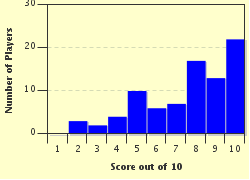Quiz Answer Key and Fun Facts
1. The clear skies of Arizona have made it popular with astronomers. Which dwarf planet was discovered by Clyde Tombaugh while working at the Lowell Observatory in Flagstaff in 1930?
2. The origins of this science date back hundreds of years, but it was in 1937 that astronomer A.E. Douglass established a laboratory at the University of Arizona to formally study the technology. Douglass was credited with founding which science that studies tree rings?
3. Some of the oldest dinosaur bones ever discovered were found in Arizona, and in 1942, the first specimen of one of the largest carnivores known was discovered in the Kayenta Formation on the Navajo Nation. Which dinosaur, whose name means two-crested lizard, was it?
4. In the 1960s, a City of Phoenix engineer named Charles McDonald created something that makes our daily highway commute quieter. What item did McDonald initially invent while repairing potholes?
5. In 1962, a product called Kool Deck was invented by the Mortex Manufacturing Company in Tucson, Arizona. For what purpose was Kool Deck used?
6. The Astrogeology Science Center was opened in 1963 in Flagstaff, Arizona, because of its proximity to the Sunset Crater lava fields and to Meteor Crater. For what purpose was the facility created?
7. In 1974, a NASA researcher named Jack Cover invented an item that was originally classified as a firearm because it used gunpowder. In the early 1990s, brothers Rick and Thomas Smith worked with Cover in Scottsdale, Arizona, to modify the design of which controversial device?
8. What happens when you lock a group of researchers in a self-contained ecosystem for two years? We found out in a three-acre structure in the Arizona desert. Which 1990s experiment suffered from oxygen and food deprivation, mass extinctions, insect infestations and internal bickering?
9. In 1958, Flagstaff, Arizona, became the first community in the United States to pass a lighting ordinance banning advertising searchlights. In 2001, because of the city's continued commitment to reducing light pollution, Flagstaff was the first location in the world to be awarded which designation?
10. In 2007, the Lunar and Planetary Laboratory at the University of Arizona in Tucson became the first public university team to lead a mission to Mars. What was the Arizona-appropriate name of the landing craft that confirmed the presence of water ice in the northern polar region of Mars in 2008?
Source: Author
PDAZ
This quiz was reviewed by FunTrivia editor
rossian before going online.
Any errors found in FunTrivia content are routinely corrected through our feedback system.

